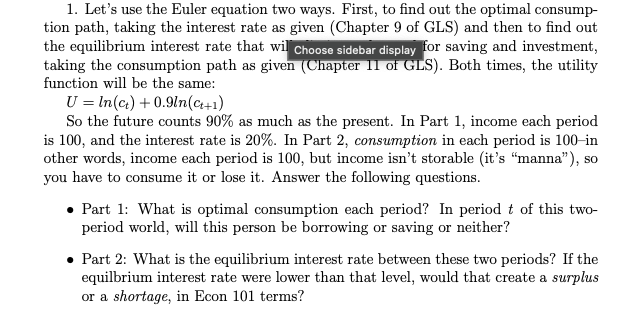1. Let's use the Euler equation two ways. First, to find out the optimal consump- tion path, taking the interest rate as given (Chapter 9 of GLS) and then to find out the equilibrium interest rate that wil Choose sidebar display for saving and investment, taking the consumption path as given (Chapter 11 of GLS). Both times, the utility function will be the same: Uln(c)+0.9ln(+1) So the future counts 90% as much as the present. In Part 1, income each period is 100, and the interest rate is 20%. In Part 2, consumption in each period is 100-in other words, income each period is 100, but income isn't storable (it's "manna"), so you have to consume it or lose it. Answer the following questions. Part 1: What is optimal consumption each period? In period t of this two- period world, will this person be borrowing or saving or neither? ⚫ Part 2: What is the equilibrium interest rate between these two periods? If the equilbrium interest rate were lower than that level, would that create a surplus or a shortage, in Econ 101 terms?
1. Let's use the Euler equation two ways. First, to find out the optimal consump- tion path, taking the interest rate as given (Chapter 9 of GLS) and then to find out the equilibrium interest rate that wil Choose sidebar display for saving and investment, taking the consumption path as given (Chapter 11 of GLS). Both times, the utility function will be the same: Uln(c)+0.9ln(+1) So the future counts 90% as much as the present. In Part 1, income each period is 100, and the interest rate is 20%. In Part 2, consumption in each period is 100-in other words, income each period is 100, but income isn't storable (it's "manna"), so you have to consume it or lose it. Answer the following questions. Part 1: What is optimal consumption each period? In period t of this two- period world, will this person be borrowing or saving or neither? ⚫ Part 2: What is the equilibrium interest rate between these two periods? If the equilbrium interest rate were lower than that level, would that create a surplus or a shortage, in Econ 101 terms?
Chapter17: Capital And Time
Section: Chapter Questions
Problem 17.2P
Related questions
Question

Transcribed Image Text:1. Let's use the Euler equation two ways. First, to find out the optimal consump-
tion path, taking the interest rate as given (Chapter 9 of GLS) and then to find out
the equilibrium interest rate that wil Choose sidebar display for saving and investment,
taking the consumption path as given (Chapter 11 of GLS). Both times, the utility
function will be the same:
Uln(c)+0.9ln(+1)
So the future counts 90% as much as the present. In Part 1, income each period
is 100, and the interest rate is 20%. In Part 2, consumption in each period is 100-in
other words, income each period is 100, but income isn't storable (it's "manna"), so
you have to consume it or lose it. Answer the following questions.
Part 1: What is optimal consumption each period? In period t of this two-
period world, will this person be borrowing or saving or neither?
⚫ Part 2: What is the equilibrium interest rate between these two periods? If the
equilbrium interest rate were lower than that level, would that create a surplus
or a shortage, in Econ 101 terms?
Expert Solution
This question has been solved!
Explore an expertly crafted, step-by-step solution for a thorough understanding of key concepts.
This is a popular solution!
Trending now
This is a popular solution!
Step by step
Solved in 2 steps

Recommended textbooks for you

